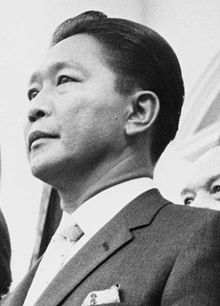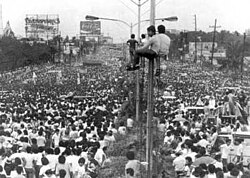The Marcos Regime started when Ferdinand E. Marcos was elected as the 10th President of the Philippines on December 1965. This was the most controversial era in the Philippine History.
During his first term, industrialization increased and a lot of solid infrastructures were created, such as the North Luzon Expressway and the Maharlika Highway, this was why Philippines was affluent during his first term. Unfortunately, everything seemed to have vanished on his next term. It was during his second term when the challenges and devastations continually grew. There were students demanding for educational reforms, a rising crime rate, and a growing Communist Rebellion.
Ferdinand Marcos supported the American military buildup in Vietnam. Though the opposition was against this plan, he managed to get the Congressional approval to send Philippine troops to Vietnam.
On September 21, 1972, Marcos declared Martial Law (Proclamation 1081), which was signed on the 21st of September and was announced to the nation evening of Sept 23. His main reasons for declaring Martial Law was "to save the Republic" and "to reform society". During that time, press freedom was shut down and congress was abolished. The arrest of opposition leaders and militant activists were ordered and a curfew was strictly implemented, which resulted to an increase in crime rates. Martial Law lasted for eight years, 3 months and 26 days and was only lifted on January 17, 1981.
After 9 years, on June 16, 1981, presidential election Marcos won for a second time by over 16 million votes and took his oath on the 30th of June.
Even though the constitution of our country limits the presidency to two four year terms, Marcos was in his position for 20 years. He ruled the Philippines as if it was his own. He controlled the military, courts, press and also the business monopolies.
In 1980, Marcos allowed Benigno Aquino to leave the country for a heart bypass operation in the United States. It was on August 21, 1983 when Aquino returned to the Philippines and was assassinated. , Marcos banned different TV stations from showing Aquino's funeral all over the Philippines. As this happened, thousands of people showed up and came out of their way just to pay tribute to the late senator's funeral.
This assassination affected the Philippine economy, the tourism industry suffered and the traditional exports, such as sugar and coconut oil experienced price a great declined in the world market resulting to a foreign debt reaching $26 billion. Marcos tried to launch recovery program; however, it was a failure due to the lack of credibility of Marcos and due to rampant graft and corruption in the government.
For the election on February 7, 1986, Ferdinand Marcos won the election once more, but Mrs. Corazon Aquino believed that the results were fraudulent and that she was the one who won the election. Even international observers, like the United States of America, denounced the results.
On Feb. 16, 1986, Corazon Aquino launched a civil disobedience nationwide at Luneta. Marcos tried to save his government and gave an indication to impose martial law again but before his plan was carried out, EDSA Revolution of 1986 broke out.
Evening of February 22, 1986, Enrile and Ramos announced in a press conference in Camp Aguinaldo that they were breaking away from the fold of the Marcos Dictatorship, barricaded themselves in Camp Aguinaldo and supported Corazon Aquino.
The Marcos regime ended with Former Pres. Marcos losing the control over the government and was forced to vacate his position and was into exile in Hawaii. Leaving the presidential position open for the rightful winner of the election, the late President Corazon Aquino.
References:
History of the Philippines (1965–1986). (2011, November 16). In Wikipedia, The Free Encyclopedia. Retrieved 07:57, December 8, 2011, from http://en.wikipedia.org/w/index.php?title=History_of_the_Philippines_(1965%E2%80%931986)&oldid=460984126
"Republic of the Philippines, The Marcos Regime"http://www.countriesquest.com/asia/philippines/history/republic_of_the_philippines/the_marcos_regime.htm
"THE PHILIPPINES UNDER FERDINAND MARCOS"http://www.oocities.org/collegepark/pool/1644/marcosera.htm
"PEOPLE POWER IN THE PHILIPPINES"


